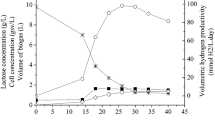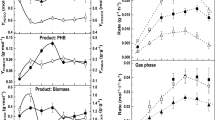Abstract
Photofermentative production of hydrogen is a promising and sustainable process; however, it should be coupled to dark fermentation to become cost effective. In order to integrate dark fermentation and photofermentation, the suitability of dark fermenter effluents for the photofermentative hydrogen production must be demonstrated. In this study, thermophilic dark fermenter effluent (DFE) of sugar beet thick juice was used as a substrate in photofermentation process to compare wild-type and uptake hydrogenase-deficient (hup −) mutant strains of Rhodobacter capsulatus by means of hydrogen production and biomass growth. The tests were conducted in small-scale (50 mL) batch and large-scale (4 L) continuous photobioreactors in indoor conditions under continuous illumination. In small scale batch conditions, maximum cell concentrations were 0.92 gdcw/L c and 1.50 gdcw/L c, hydrogen yields were 34 % and 31 %, hydrogen productivities were 0.49 mmol/(L c·h) and 0.26 mmol/(Lc·h), for hup − and wild-type cells, respectively. In large-scale continuous conditions, maximum cell concentrations were 1.44 gdcw/L c and 1.87 gdcw/L c, hydrogen yields were 48 and 46 %, and hydrogen productivities were 1.01 mmol/(L c·h) and 1.05 mmol/(L c·h), for hup − and wild-type cells, respectively. Our results showed that Rhodobacter capsulatus hup − cells reached to a lower maximum cell concentration but their hydrogen yield and productivity were in the same range or superior compared to the wild-type cells in both batch and continuous operating modes. The maximum biomass concentration, yield and productivity of hydrogen were higher in continuous mode compared to the batch mode with both bacterial strains.




Similar content being viewed by others
References
Koku H et al (2002) Aspects of the metabolism of hydrogen production by Rhodobacter sphaeroides. Int J Hydrogen Energy 27:1315–1329
Uyar B, et al (2012) Hydrogen production via photofermentation, in state of the art and progress in production of biohydrogen. Azbar N, Levin D (eds). Bentham Science Publishers, USA
Claassen PAM, de Vrije T (2006) Non-thermal production of pure hydrogen from biomass: HYVOLUTION. Int J Hydrogen Energy 31:1416–1423
Nanqi R et al (2011) Biological hydrogen production by dark fermentation: challenges and prospects towards scale up production. Opin Biotechnol 22:365–370
Ozgür E et al (2010) Biohydrogen production from beet molasses by sequential dark and photofermentation. Int J Hydrogen Energy 35(2):511–517
Uyar B et al (2009) Photoproduction of hydrogen by Rhodobacter capsulatus from thermophilic fermentation effluent. Bioprocess Biosyst Eng 32:603–606
Afsar N et al (2006) Hydrogen productivity of photosynthetic bacteria on dark fermenter effluent of potato steam peels hydrolysate. Int J Hydrogen Energy 36(1):432–438
Avcioglu SG et al (2011) Biohydrogen production in an outdoor panel photobioreactor on dark fermentation effluent of molasses. Int J Hydrogen Energy 36(17):11360–11368
Özkan E et al (2012) Photofermentative hydrogen production using dark fermentation effluent of sugar beet thick juice in outdoor conditions. Int J Hydrogen Energy 37(2):2044–2049
Oztürk Y et al (2006) Hydrogen production by using Rhodobacter capsulatus mutants with genetically modified electron transfer chains. Int J Hydrogen Energy 31:1545–1552
Biebl H, Pfennig H (1981) Isolation of members of the family Rhodospirillaceae. The prokaryotes (ed). Starr MP et al., New York, Springer-Verlag
Ntaikou I, Antonopoulou G, Lyberatos G (2010) Biohydrogen production form biomass and wastes via dark fermentation: a review. Waste Biomass Valorization 1:21–39
Ozgür E et al (2010) Biohydrogen production by Rhodobacter capsulatus on acetate at fluctuating temperatures. Resour Conserv Recycl 54(5):310–314
Asada Y et al (2008) Re-evaluation of hydrogen productivity from acetate by some photosynthetic bacteria. Int J Hydrogen Energy 33(19):5147–5150
Akköse S et al (2009) Effects of ammonium ion, acetate and aerobic conditions on hydrogen production and expression levels of nitrogenase genes in Rhodobacter sphaeroides O.U.001. Int J Hydrogen Energy 34(21):8818–8827
Kars G et al (2006) Hydrogen production and transcriptional analysis of nifD, nifK and hupS genes in Rhodobacter sphaeroides O.U.001 grown in media with different concentrations of molybdenum and iron. Int J Hydrogen Energy 31(11):1536–1544
Uyar B et al (2007) Effect of light intensity, wavelength and illumination protocol on hydrogen production in photobioreactors. Int J Hydrogen Energy 32(18):4670–4677
Androga DD et al (2011) Significance of carbon to nitrogen ratio on the long-term stability of continuous photofermentative hydrogen production. Int J Hydrogen Energy 36(24):15583–15594
Eroglu E et al (2011) Effect of iron and molybdenum addition on photofermentative hydrogen production from olive mill wastewater. Int J Hydrogen Energy 36:5895–5903
Modigell M, Holle N (1998) Reactor development for a biosolar hydrogen production process. Renew Energy 14:421–426
Akman MC et al (2015) Investigation of the effects of initial substrate and biomass concentrations and light intensity on photofermentative hydrogen gas production by Response Surface Methodology. Int J Hydrogen Energy 40(15):5042–5049
Androga DD et al (2011) Significance of carbon to nitrogen ratio on the long-term stability of continuous photofermentative hydrogen production. Int J Hydrogen Energy 36(24):15583–15594
Gebicki J et al (2010) Comparison of two reactor concepts for anoxygenic H2 production by Rhodobacter capsulatus. J Clean Prod 18:S36–S42
Boran E, Ozgür E, Burg J, Yücel M, Gündüz U, Eroglu I (2010) Biological hydrogen production by Rhodobacter capsulatus in solar tubular photo bioreactor. J Clean Prod 18(1):29–35
Boran E, Ozgür E, Yücel M, Gündüz U, Eroglu I (2012) Biohydrogen production by Rhodobacter capsulatus hup − mutant in pilot solar tubular photobioreactor. Int J Hydrogen Energy 37(21):16437–16445
Acknowledgments
This study was financially supported by the Commission of the European Communities, 6th Framework Programme, Priority 6, Sustainable Energy Systems (019825 HYVOLUTION). The authors thank Profactor GmbH for kindly providing the sugar beet thick juice dark fermentation effluent samples and Dr. Yavuz Öztürk for the hup − mutant strain of R. capsulatus.
Author information
Authors and Affiliations
Corresponding author
Rights and permissions
About this article
Cite this article
Uyar, B., Gürgan, M., Özgür, E. et al. Hydrogen production by hup− mutant and wild-type strains of Rhodobacter capsulatus from dark fermentation effluent of sugar beet thick juice in batch and continuous photobioreactors. Bioprocess Biosyst Eng 38, 1935–1942 (2015). https://doi.org/10.1007/s00449-015-1435-2
Received:
Accepted:
Published:
Issue Date:
DOI: https://doi.org/10.1007/s00449-015-1435-2




